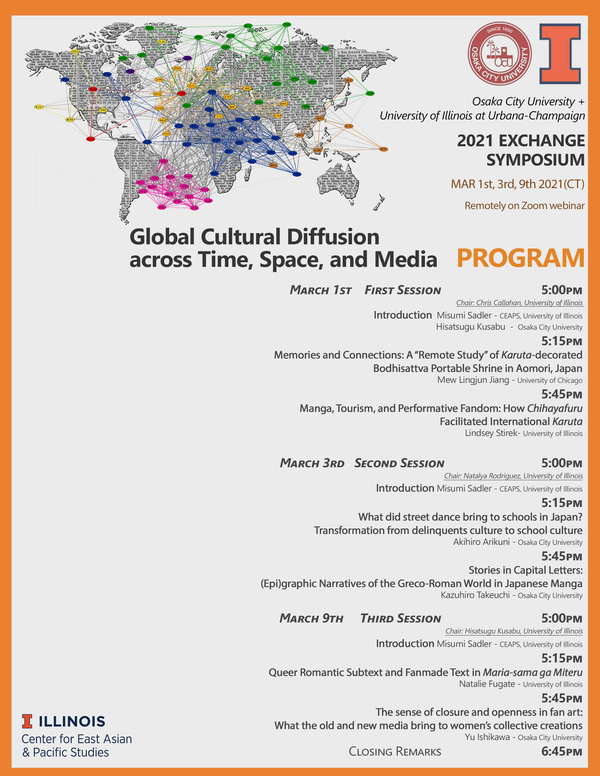
Illinois - Osaka City University Exchange Symposium Series 2021: “Global Cultural Diffusion across Time, Space, and Media” (Session 1)
- Event Type
- Seminar/Symposium
- Sponsor
- Center for East Asian and Pacific Studies
- Date
- Mar 1, 2021 5:00 - 6:45 pm
- Registration
- Registration
- Contact
- Center for East Asian and Pacific Studies
- ceaps@illinois.edu
- Views
- 217
- Originating Calendar
- CEAPS Events Calendar
The Center for East Asian and Pacific Studies at University of Illinois at Urbana-Champaign and The Urban-Culture Research Center (UCRC) at Osaka City University (OCU) Present
Illinois - Osaka City University Exchange Symposium Series 2021: “Global Cultural Diffusion across Time, Space, and Media”
March 1-9, 2021, VirtualSession 1: “Karuta at Play: Local Gods to Global Games”
Monday, March 1, 2021, 5:00-6:45 pm US Central Time
Session Chair: Chris Callahan (EALC, University of Illinois)- 5:00-5:10 pm
Introduction
Misumi Sadler (CEAPS, University of Illinois); Hisatsugu Kusabu (OCRC, Osaka City University) - 5:15-5:45 pm
Mew Lingjun Jiang (University of Chicago)
“Memories and Connections: A “Remote Study” of Karuta-decorated Bodhisattva Portable Shrine in Aomori, Japan” - 5:45-6:15 pm
Lindsey Stirek (University of Illinois)
“Manga, Tourism, and Performative Fandom: How Chihayafuru Facilitated International Karuta” - 6:15-6:45 pm
Q & A
ABSTRACTS
Memories and Connections: A “Remote Study” of Karuta-decorated Bodhisattva Portable Shrine in Aomori, Japanaruta at Play: Local Gods to Global Games
by Mew Lingjun Jiang, University of ChicagoThis study looks into a Kannon Bodhisattva zushi portable shrine that enshrines the Deity of Karuta-Gambling in Sannohe, Aomori. The study is part of a project of the history of karuta that came through European merchants in the late sixteenth but later developed into various regional designs and continued into modern times. Decorated with the regional-patterned karuta “Kurofuda,” the zushi in Nose Kannon Hall is devoted to both the Shō-Kanzeon, “True Bodhisattva,” and Kakegoto no kamisama, “The Deity of Gambling” (fig. 1). The zushi presents an interesting case of Shinto-Buddhist integration in which the Europe-originated, Portuguese-patterned karuta (Por. carta) Japanese playing cards became sacralized as the Deity of Gambling and coexists with Buddhist icons. This study examines the history of Nose Kannon Hall, with evidence from documents, interviews, and images provided by the Sannohe town. While the Nose Kannon Hall is a historical place enshrining Buddhist icons, the local belief in the Shinto kami integrates through the reinterpretation of icons and the sacralization of karuta used by travelers and residents in Nose, a place that once had important crossroads in the Edo period (1603-1868). The coexistence of the Shō-Kanzeon and the Deity of Gambling became possible because of Nose’s location and local karuta-gambling gatherings. The karuta-decorated zushi manifests this Shinto-Buddhist integration and preserves local traditions through religious events like decennial go-kaichō public displays.
The study also showcases an online collaborative work under the time of COVID-19 travel restrictions. To better document the zushi, I planned a field study in Summer 2020 but had to cancel it. Instead, I collaborated online with traditional-game researchers and linguists from Tokyo, Kyoto, Osaka, and Aomori. The remote study connects people and the zushi through images and interviews to record and preserve memories of the local community to understand religious practices and the continuation of traditional games and customs in Northeast Japan.Manga, Tourism, and Performative Fandom: How Chihayafuru Facilitated International Karuta
by Lindsey Stirek, University of Illinois
Though they found their foothold in the U.S. slightly later than anime, with an increase in available translations and changes to international formatting standards to bring translations more in line with the original publications, manga have become an integral vehicle for the spread of Japanese culture. While American readers may recognize many elements of Japanese culture, manga have provided a means to access less commonly known arts and practices as well.
One such practice is the uniquely Japanese sport of competitive karuta, a poetry-based card game, which was practically unknown outside Japan until recently. Even in Japan, this game was largely relegated to a New Year’s tradition and a game for older women before the publication of Suetsugu Yuki’s Chihayafuru in 2008. Chihayafuru blends elements of the popular sports genre with techniques and themes from shojo (girls’) manga, creating broad appeal and drawing the interest of a new generation of potential karuta players. The success of the manga led to an anime and three live action films as well as a range of spin-offs and merchandising and eventually, official English translations, opening it up to an international audience.
Visitors both international and domestic have made fan pilgrimages to the epicenter of karuta competitions, Ōmi Jingu, and the number of competitors in karuta competitions across Japan have increased every year since the first volume of Chihayafuru came out. A large competition welcoming foreigners was planned to coincide with the 2020 Olympics until the pandemic forced postponement. In this paper, I aim to present Chihayafuru as a case study of the immense and broad impact manga can have in Japan and abroad.
- 5:00-5:10 pm